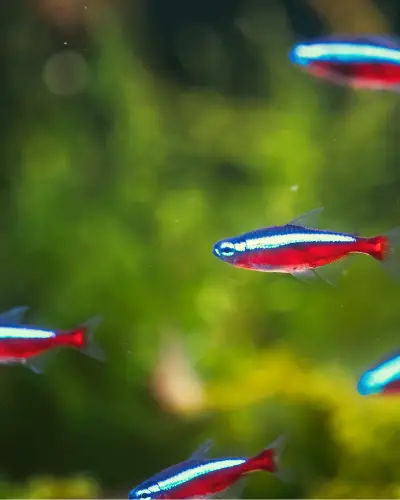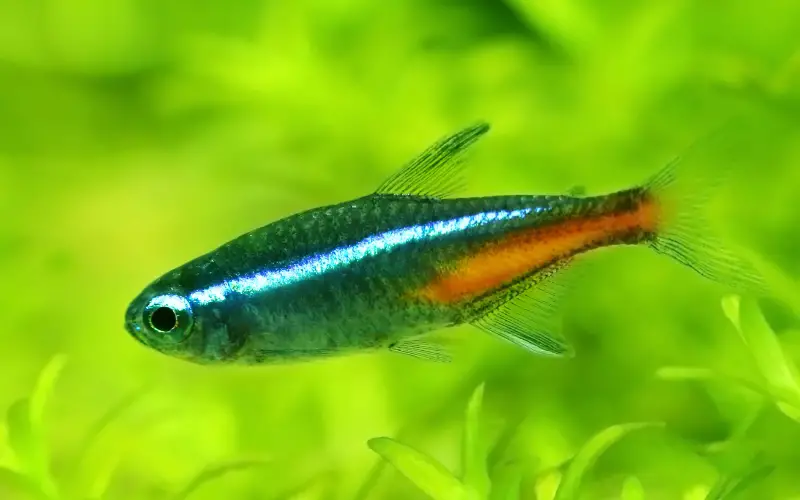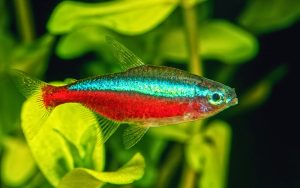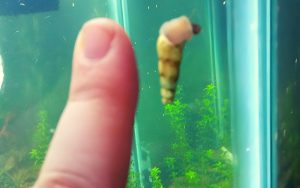Are you ready to dive into the mesmerizing world of the Cardinal Neon Tetra? If you’re a passionate aquarium enthusiast or want to add a splash of vibrant color to your aquatic oasis, you’re in for a treat!
In this comprehensive guide, we’ll unveil the captivating secrets of the Cardinal Neon Tetra and equip you with the knowledge to create a thriving habitat for these stunning creatures.
Imagine a shimmering display of radiant reds, vibrant blues, and electrifying silvers gracefully gliding through your aquarium.
The Cardinal Neon Tetra, with its captivating beauty and peaceful nature, has become a favorite among fishkeepers around the globe. But there’s more to these tiny aquatic wonders than meets the eye!

In this article, we will explore the origins of the Cardinal Neon Tetra, unravel its distinct characteristics, and reveal the secrets to maintaining a healthy and thriving Cardinal Tetra community.
Whether you’re a beginner or an experienced aquarist, this guide will provide invaluable insights and tips for ensuring the optimal care and well-being of your Cardinal Neon Tetra.
So, get ready to embark on an exciting journey as we uncover the fascinating world of the Cardinal Neon Tetra and discover why it has captured the hearts of fish enthusiasts everywhere!
Table of Contents
ToggleCardinal Neon Tetra Species Profile (Paracheirodon axelrodi)
The Cardinal Tetra (Paracheirodon axelrodi) is one of the most popular freshwater fish in the aquarium hobby. It is known for its vibrant colors and peaceful temperament.
Scientific Name: Paracheirodon axelrodi
Size: Up to 2 inches (5 cm)
Temperament: Peaceful, schooling fish
Water Parameters:
- pH: 5.5 – 7.0 (slightly acidic)
- Temperature: 73°F – 80°F (23°C – 27°C)
- Hardness: 2° to 6° dH
Lifespan: 2 – 5 years
Cardinal tetras are schooling fish, meaning Tetras do best in groups of 6 or more. They are relatively easy to care for, making them an excellent choice for beginner aquarists. Their vibrant red and blue coloration adds a touch of beauty to any aquarium.
Here are some things to keep in mind when caring for Cardinal Tetras:
- Tank Size: Cardinal tetras are relatively small fish but need some space to swim. A 10-gallon tank is the minimum recommended size for a school of 6 fish.
- Water Quality: Cardinal tetras are sensitive to water quality. It is important to maintain a clean and stable environment for them, with regular water changes and a good filtration system.
- Diet: Cardinal tetras are omnivores. They will eat various foods, including flake food, brine shrimp, frozen foods, live foods, and bloodworms.
- Tank Mates: Cardinal tetras are peaceful fish and can be kept with other peaceful community fish. However, they should not be kept with large or aggressive fish that could eat them.
The Cardinal Tetra is a great option if you are looking for a beautiful and easy-to-care-for freshwater fish. With proper care, they can thrive in your aquarium for many years.
Origin and Distribution of Neon Fish Tetra: A Jewel for Your Aquarium
Neon tetras, scientifically, are popular aquarium fish native to the Orinoco and Negro river basins in South America. They are often confused with cardinal tetras, another species in the aquarium trade. The main difference between cardinal tetras and neon tetras is the cardinal’s red stripe and the neon’s blue stripe.

Neon tetras are slow-moving, iridescent blue fish laterally bisected with a thin blue stripe. In captivity, they can grow to an adult size of about 1.5 inches. Neon tetras are active schooling fish and thrive in a well-maintained fish tank. Breeders like Aquarium Co-Op offer a care guide to support the sustainable cardinal fishery of the Amazon.
The Neon Tetra, scientifically known as Paracheirodon innesi, originates from South America’s blackwater and clearwater streams. Its native range stretches across Colombia, Peru, and Brazil, particularly within the Amazon River basin. These regions are characterized by dense vegetation, subdued lighting due to the rainforest canopy, and soft, acidic water.
Within this ornamental fish habitat, Neon Tetras tend to inhabit the middle and lower levels of the water column, often forming large schools for protection and social interaction. Their vibrant coloration serves as camouflage amongst the dappled light and live plants and as a means of communication within the school.
Are Cardinal Tetras Hard to Keep?
Cardinal Tetras are generally considered moderately easy to keep, making them suitable for both beginner and experienced aquarium hobbyists. However, they have specific care requirements that must be met to ensure their well-being.
Here’s a breakdown of why they are considered moderately easy:
Pros:
- Peaceful Temperament: Cardinal Tetras are schooling fish and thrive in groups. Their calm nature makes them ideal community fish, compatible with other non-aggressive species of similar size.
- Active and Engaging: Their vibrant colors and active swimming behavior bring life and movement to any aquarium, making them a joy to observe.
- Adaptable Diet: They readily accept commercially available fish foods, including flakes, pellets, and frozen or live options like brine shrimp and daphnia.
Challenges:
- Water Parameters: Cardinal Tetras are sensitive to water conditions and require stable, clean water with specific parameters, including soft, acidic water. Regular water changes and proper filtration are crucial.
- Temperature Sensitivity: They prefer warmer water temperatures, which might require a heater, depending on your climate.
- Susceptibility to Disease: While generally hardy, they can be susceptible to certain diseases, especially if water quality is not maintained.
Overall:
With proper care and attention to their specific needs, Cardinal Tetras can thrive in a home aquarium. Providing a suitable environment, stable water conditions, a balanced diet, and peaceful tank mates will give these tropical fish years of enjoyment.
Aquarium Supplies and Water pH Maintenance
Cardinal and neon tetras are very popular for aquarium enthusiasts due to their vivid red coloration. These small fish are best kept in schools to showcase their beauty.
However, they can be challenging to breed in captivity, requiring a pH of 6.0, similar to their natural habitat in Manaus. The neon tetras look stunning with their blue and red bodies, with a red stripe that stretches across their entire school.
Their striking iridescent blue line characteristic makes them a popular choice for any aquarium. Ichthyologists believe fishkeepers should continue to support the sustainable fishery of the Amazon Basin, whether the fish are bred or wild-caught due to damaged fins.
Green Neon Tetra vs Cardinal Tetra Species Comparison
Cardinal Tetras and Green Neon Tetras are popular choices for freshwater aquariums, and while they look similar, there are some key distinctions:
Appearance:
- Color: Both have a vibrant blue line along the body. Cardinal Tetras have a bold red stripe running from head to tail, while Green Neon Tetras have a shorter red stripe starting mid-body and reaching the tail.
- Size: Cardinal Tetras are slightly larger, reaching up to 2 inches (5 cm), compared to Green Neon Tetras at 1.5 inches (3.8 cm).
- Body Shape: Cardinal Tetras have a more streamlined, torpedo-like body, whereas Green Neon Tetras are shorter and rounder.
Care:
- Water Parameters: Both prefer slightly acidic, soft water with similar temperature ranges (73°F – 80°F).
- Temperament: Both are peaceful schooling fish and thrive in groups of 6 or more.
- Diet: They are omnivores and enjoy various flake foods, brine shrimp, and bloodworms.
Other Considerations:
- Availability: Cardinal Tetras are more widely available and generally less expensive.
- Hardiness: There’s some debate, but Cardinal Tetras are often considered slightly hardier due to less inbreeding in captivity than Green Neon Tetras.
Here’s a table summarizing the key differences:
| Feature | Cardinal Tetra | Green Neon Tetra |
|---|---|---|
| Color | Red stripe full body length | Red stripe mid-body to tail |
| Size (max) | 2 inches (5 cm) | 1.5 inches (3.8 cm) |
| Body Shape | Streamlined, torpedo-like | Shorter, rounder |
| Water Parameters | Soft, slightly acidic (pH 5.5-7.0, temp 73-80°F) | Soft, slightly acidic (pH 5.5-7.0, temp 73-80°F) |
| Temperament | Peaceful, schooling | Peaceful, schooling |
| Diet | Omnivore | Omnivore |
| Availability | More common | Less common |
| Hardiness | Possibly hardier | May be more delicate |
Ultimately, the best choice depends on your preference. If you prioritize a bold red stripe and a slightly larger size, Cardinal Tetras are an excellent option. Green Neon Tetras might be the way to go if you prefer a more delicate look with a shorter red stripe and potentially easier breeding (for experienced aquarists).
Are Neon Tetras Best for Community Tanks?
Neon tetra is a very popular for community tanks due to their peaceful nature and vibrant colors. The neon tetra is known for its ornamental value, with its iconic neon’s blue stripe laterally bisecting the fish.
On the other hand, the cardinal tetra has the striking iridescent stripe running the length of its body, making it a visually stunning addition to any tank.
When deciding which tetra is best for a community aquarium, it’s essential to determine if the Neon fish tetra is bred or wild-caught, as wild-caught specimens may not adapt as well to aquarium life.
Both fish are similar and do best in schools of at least six individuals. Cardinal tetras are found in the upper Orinoco and Negro rivers in South America, reproducing in leaf litter and providing a colorful display for any breeding tank. However, other inhabitants might turn their attention to the smaller neon tetras in a community tank due to their flashy colors.
Commonly Asked Questions about Keeping Cardinal Neon Tetra Fish Species (FAQs)
How many Cardinal Tetras should be kept together?
Aim for a school of at least 6 Cardinal Tetras. They thrive in numbers for better safety and exhibit beautiful schooling behavior.
Can you mix cardinal tetras with neon tetras?
Can you mix neon and Cardinal Tetras? Yes, Cardinal and Neon Tetras can be mixed! They have similar care needs and schooling behavior, making them peaceful tankmates.
Are Cardinal Tetras better than Neon Tetras?
Cardinal tetras are a close call! They have richer colors and are potentially hardier but need slightly softer water and cost more. Neons are easier to care for and budget-friendly.
Are Cardinal Tetras aggressive?
Cardinal Tetras are generally peaceful community fish. However, they can show nipping behavior towards slow-moving fish with long fins.
Are 5 Cardinal Tetras enough?
No, 5 Neon fish tetra are not ideal. These schooling fish feel safer and thrive in groups of 8-10 or more.
How much space do Cardinal Tetras need?
Cardinal tetras thrive in schools and need a minimum of 20 gallons for a small group of 6 fish. More space is recommended for larger schools.
How do we determine if the cardinal tetra is bred or wild-caught?
Unfortunately, there’s no physical way to tell just by looking. Most cardinal tetras are wild-caught, but captive breeding is increasing. Your best bet is to ask the seller for details on their source.
How do you treat neon tetra disease?
Neon tetra disease has no known cure. Focus on preventing its spread through isolation and maintaining pristine water conditions.
Conclusion
As we reach the end of our exploration into the captivating world of the Cardinal Tetra, it becomes clear why these little fish hold such a special place in the hearts of aquarium enthusiasts. Their vibrant colors, peaceful nature, and graceful movements add a touch of magic to any aquatic environment.
By understanding their specific needs and providing the proper care, you can ensure that your Cardinal Tetras survive and thrive. From maintaining optimal water conditions and a balanced diet to creating a harmonious community within your tank, every step you take contributes to the well-being of these dazzling creatures.
So, consider inviting the Cardinal Neon tetra into your world, whether you’re a seasoned aquarist or just beginning your underwater journey. Their presence will transform your aquarium into a living masterpiece, a vibrant spectacle of color and life that brings joy with every shimmering glance.





